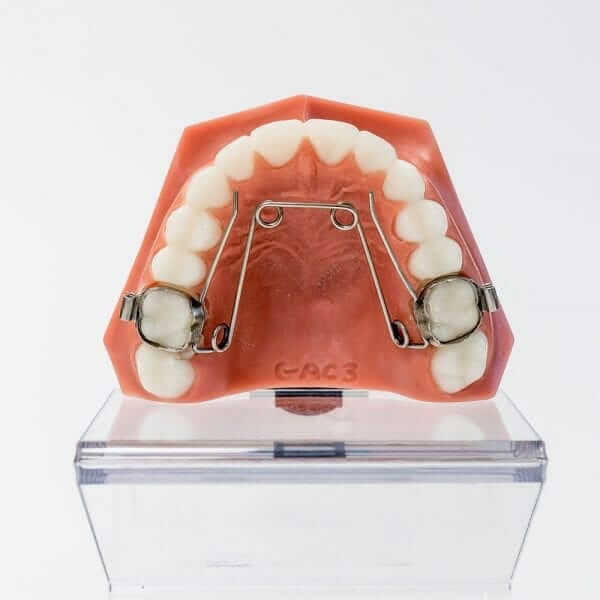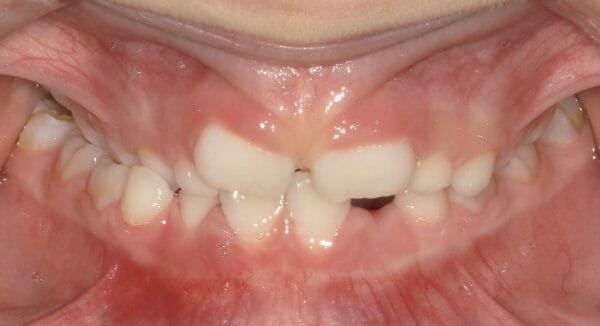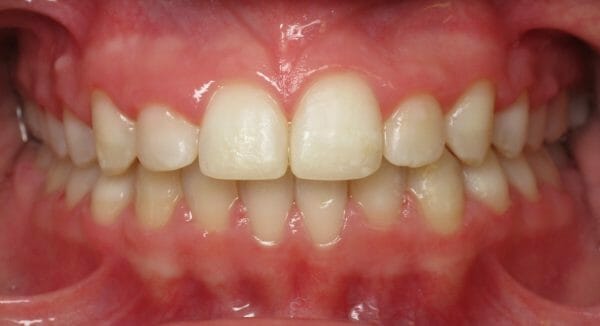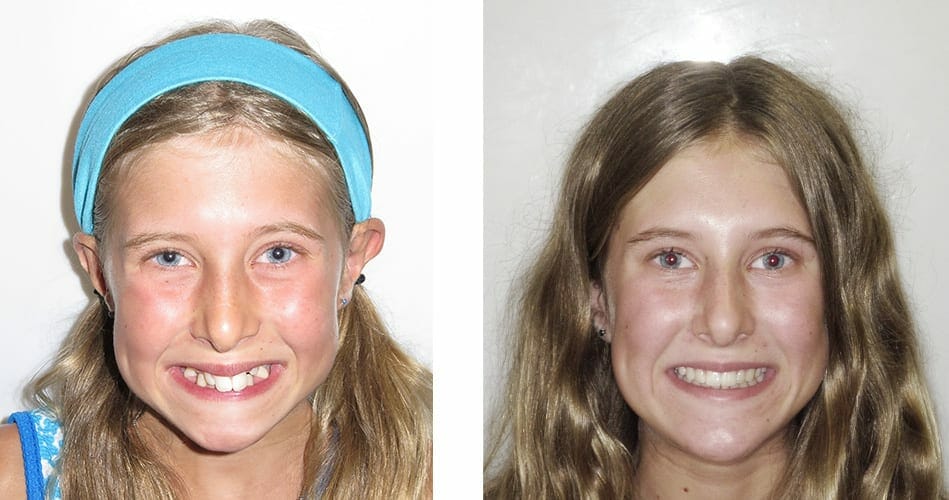Quad Helix Appliance
The definition of quad helix appliance is an orthodontic appliance that is used to gently and gradually widen a patient’s jaw. This type of device falls under the category of palatal expander. Because the quad helix expander is used on the upper teeth/jaw, it may also be called a maxillary expander. Maxillary is the term used when referring to the upper jaw. When referring to the lower jaw, the term mandibular would be used.

The quad helix appliance can be removable, but it is usually bonded to the teeth with orthodontic cement. The appliance consists of stainless-steel rings (called bands) that are anchored to the top 6-year molars. Four active springs then work together to widen the upper dental arch. These four springs are how the device got its name. Quad means “four” and helix refers to the spring shape used in the device. A stainless-steel quad helix appliance wire connects the four springs and the bands.
The device is positioned near the roof of the mouth and is typically worn for approximately 6 months, depending on how much a patient’s jaw needs to be widened. However, the 6-month timeframe is usually enough to achieve the desired expansion and provide enough time for the expansion to “set.”
Palatal Expanders
Palatal expanders are normally used in younger patients whose jaw has not yet fully developed. Before adolescence, the bones in the roof of the mouth (palate) are not yet fused. Because the bones are not yet fused, palatal expanders can be used to gently widen the growth plate (called a suture) and expand a patient’s jaw.
The quad helix appliance is generally used when only mild expansion of the jaw is required. If more extensive expansion is required, a hyrax rapid palatal expander (RPE) such as a bonded or banded expander would typically be used instead.

Advantages of the Quad Helix Appliance
One of the advantages of using a quad helix appliance is that neither the parent nor the child needs to worry about activation. With hyrax RPEs, patients or their caregivers need to activate the appliance with a key on a prescribed scheduled. With the quad helix, the device is “pre-loaded” and does not require a manual adjustment.
Instead, the device works continuously without the patient having to do anything. This is a huge benefit considering that most patients using this appliance are younger in age.
The other advantage of the quad helix appliance is that it can be used to solve serious orthodontic and dental issues before they become more difficult to fix. Known as interceptive orthodontics, this type of early intervention prevents more expensive and invasive orthodontic procedures later in life.
This is because the device is used when the jaw is still developing and is easier to shape and guide into the correct shape. Later in life (once the upper growth plate has fused), patients with narrow jaw issues must often undergo expensive and invasive jaw surgery.

Quad Helix Appliance Uses
The quad helix appliance is used to help treat several orthodontic issues, including a crossbite, a narrow jaw, and teeth crowding. Each of these issues and how the appliance can address them is discussed in more detail below.
Quad Helix Appliance for Crossbite
A posterior crossbite occurs when a patient’s upper arch width is too narrow compared to the lower arch width. Another way to describe a crossbite is when the upper back teeth sit inside (towards the roof of the mouth) of the lower back teeth. This results in a misalignment between the upper and lower jaws. To compensate, patients tend to shift their jaw to one side or the other when biting down.
Crossbites can lead to a variety of problems, including:
- Excessive wear on the biting surfaces of the teeth
- Difficulty chewing
- Facial asymmetry
By using a quad helix appliance, the upper dental arch is widened, bringing the upper and lower jaws into alignment.


Quad Helix Appliance for a Narrow Upper Jaw
Some patients have narrow upper jaws, which can lead to issues such as:
- Biting and chewing problems
- Excessive wear on teeth
- Proportion problems
- A narrow smile
A narrow upper jaw can create issues with a patient’s smile. If the upper arch is constricted, dark spaces (called “buccal corridors”) can be seen between the teeth and the corners of the mouth when smiling. Using a quad helix to address these issues early on can result in a broader and more attractive smile.
Quad Helix Appliance for Teeth Crowding
Teeth crowding can be related to having a small upper jaw. By expanding the jaw with a quad helix appliance, patients with crowded teeth gain more space for the permanent teeth to fit in the mouth. Although braces or Invisalign may still be needed later, treatment can be simplified and the risk of needing permanent teeth extracted goes down.
Overcrowded teeth can result in problems such as:
- Increased occurrence of cavities and gum disease
- Bite issues
- Embarrassment or sensitivity about smiling

What To Expect with A Quad Helix Appliance
It typically takes about a week for patients to adjust and adapt to wearing a quad helix appliance. Many patients feel some pressure or soreness on the roof of the mouth or with their tongue. The most common complaint is a sore tongue. However, after a week of adjustment, the soreness and discomfort fades away.
During that first week, patients may consider over-the-counter pain medication (such as Tylenol or Ibuprofen; as recommended by their doctor) and rinsing their mouth with warm saltwater regularly. Both remedies will help to reduce swelling and inflammation. A saltwater rinse is made by combining 1 cup of warm water with ½ teaspoon of salt. Patients should swish the salt water around in their mouth for 15 to 20 seconds and then spit it out.
As with all orthodontic appliances, patients should avoid eating sticky or chewy foods that may get stuck on the wires or springs. In addition, patients should refrain from eating hard or crunchy foods that may dislodge the appliance or loosen the wires. Otherwise, patients can brush and floss as normal. A water flosser is often the easiest way to keep orthodontic appliances clear of food debris.
To learn more about interceptive orthodontics and whether your child may benefit from a device such as the quad helix appliance, contact Burke & Redford Orthodontists at (951) 699-8011 to schedule a free orthodontic consultation. You can also complete the contact form on our website.